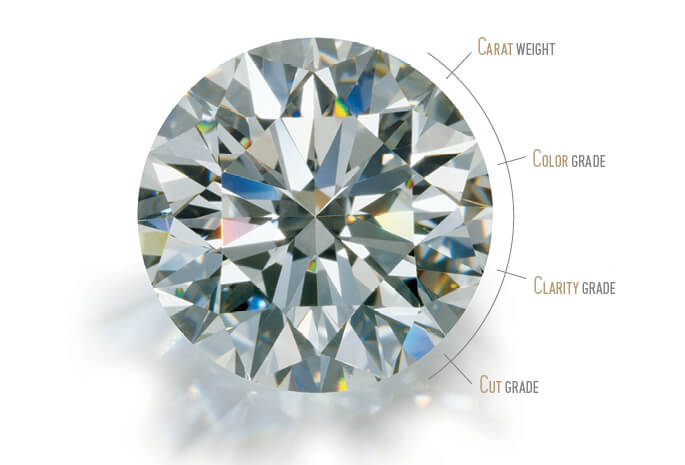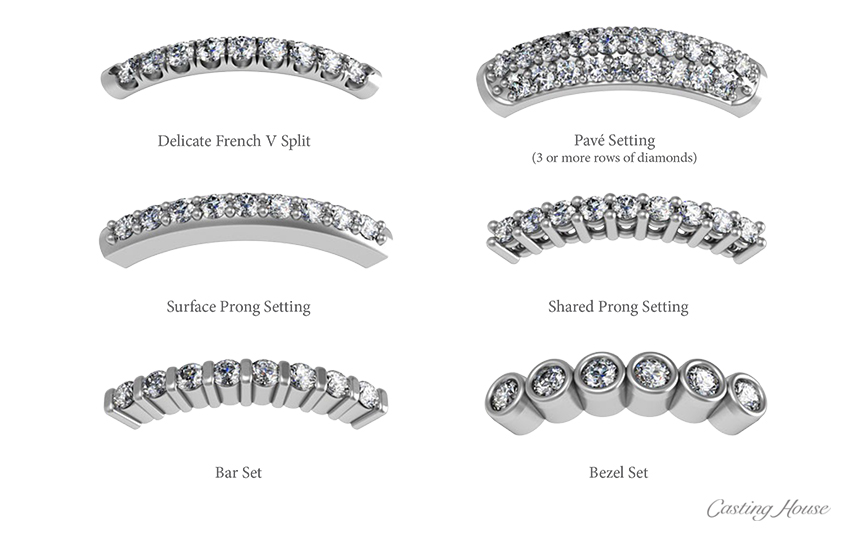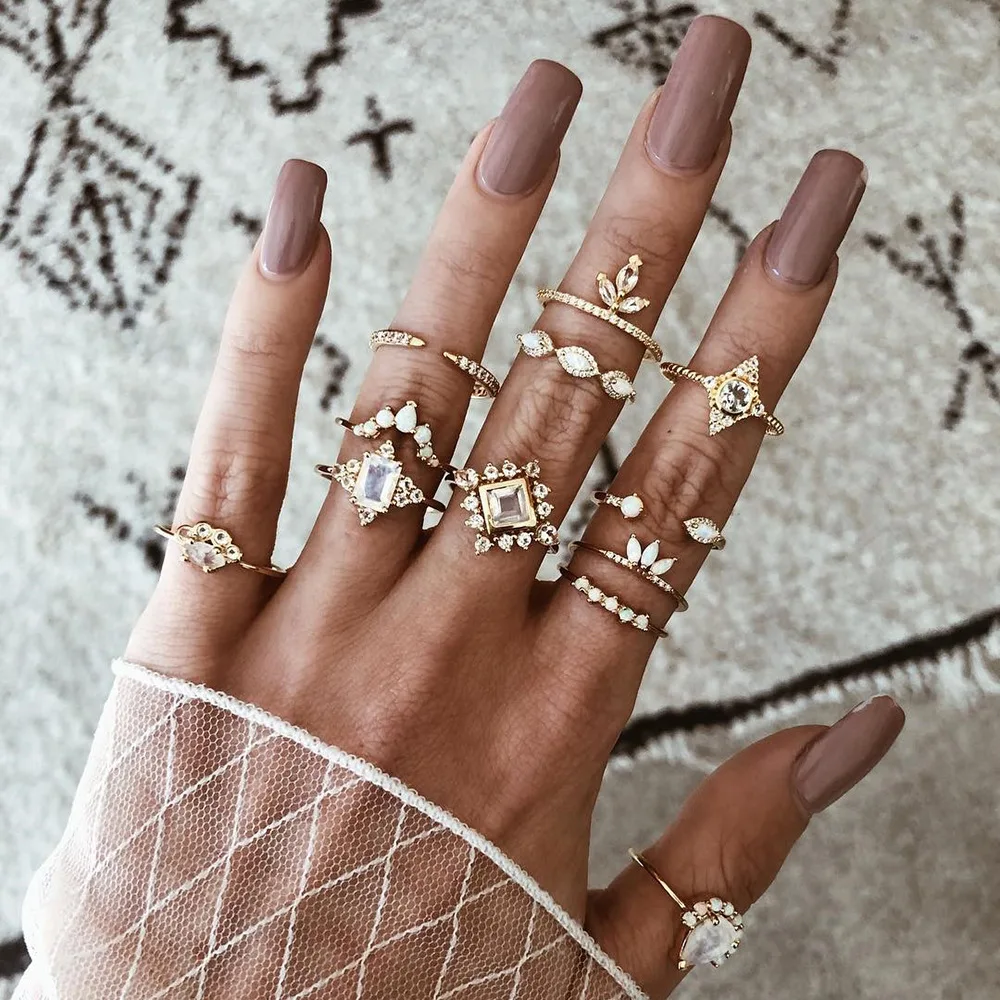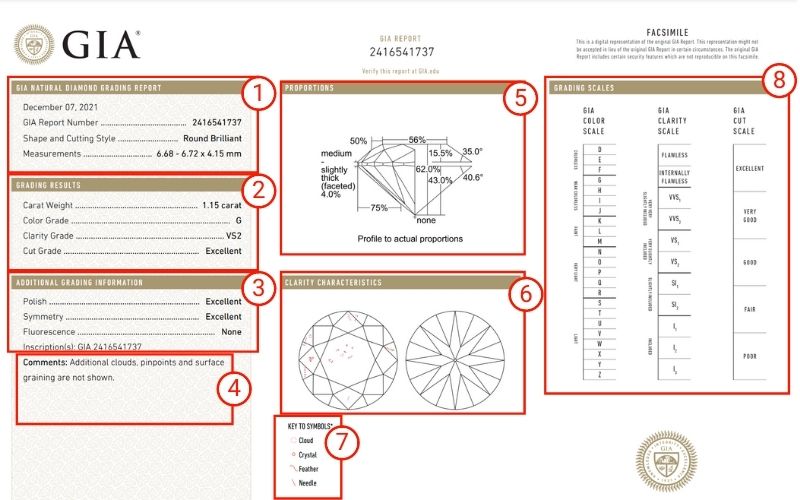An engagement ring is one of the most important – and meaningful – items you will ever give or receive. While shopping for an engagement ring can seem daunting, it should be an exciting, creative, and enjoyable experience. Use Jewelers of America’s steps to engagement ring shopping to guide you in this important decision.
An engagement ring has long symbolized a proposal of marriage. The meaning of an engagement ring speaks volumes: It’s a clear and tangible symbol that you are beloved and that the person presenting the ring wants to make your relationship official.
While any ring can be considered an engagement ring, by far the most popular engagement ring contains a diamond. Of course, the sky’s the limit when it comes to finding your perfect ring. There are no rules—and that includes, what finger the engagement ring is worn on. Traditionally in Western cultures, one wears an engagement ring on the third finger of the left hand, and, like a wedding ring, it’s a clear and very visible way to indicate that you’re in a relationship. In some cultures, they wear engagement rings on the right hand, because the left hand is unlucky.
Our guide to finding the perfect engagement ring that fits her personality and your budget
Follow these 11 tips for buying an engagement ring to make a smart purchase:
- Know the 4Cs
- Know diamond shapes and cut styles
- Look at diamonds under different lighting
- Pick a metal for the band
- Choose the setting
- Consider side stones
- Know her style, motifs, and trends
- Measure ring size
- Pick a reputable & trusted jeweler
- Insist on a diamond grading report
- Set the budget
1. Know the 4Cs
The first tip for buying a diamond engagement ring is to know the 4Cs: Color, Clarity, Cut, and Carat Weight. Created by GIA, the 4Cs are the global standard for assessing the quality of diamonds and allow us to compare one diamond to another.
In brief, the 4Cs are:
- Color: Color is graded on a D-to-Z scale, with D meaning that a diamond is completely colorless and Z meaning that a diamond has a light yellow or brown color. In this color range, diamonds with less color are rarer and more highly sought-after.
- Clarity: Diamond clarity refers to the absence of internal features, called inclusions, and surface irregularities, called blemishes. Clarity is graded on a scale from Flawless to Included.
- Cut: The quality of a diamond’s cut determines how well it interacts with light. A diamond’s proportions, symmetry, and polish determine its brightness (or brilliance), scintillation (or sparkle), and fire (flashes of color).
- Carat Weight: Diamond carat weight determines a diamond’s apparent size. Generally speaking, the greater the carat weight, the rarer and more valuable the diamond, if the other Cs are comparable.
2. Know diamond shapes and cut styles
Before one starts shopping for an engagement ring, he should understand the difference between a diamond’s shape and its cutting style. Shape describes a diamond’s outline when viewed face up. The most popular diamond shape is round. But there are other shapes—known as fancy shapes—which include the marquise, pear, oval, rectangle, square, and heart.
*Tip: Round brilliant diamonds tend to cost the most of all the shapes and cut styles. Choosing a fancy shape can be a good way to save money and choose a unique center stone.
Cutting style refers to how a diamond’s facets are arranged. The brilliant cut is popular due to how it maximizes a diamond’s brightness. This cut style has a range of shapes, from round to oval to square (princess cut) to marquise. The round brilliant cut is the most popular shape and cut combination, with 57 or 58 facets.
The step cut is another popular cutting style. Steps cuts have long, sleek lines, which gives them an elegant, sophisticated gleam. A popular step cut is an emerald cut—a square or rectangular shape with concentric rows of parallel facets and beveled corners. In contrast, a radiant cut diamond also has a square or rectangular shape but is cut in a brilliant style.
*Tip: Step cuts tend to show their color and clarity more, while brilliant cuts are better at hiding color and inclusions. If you are purchasing a step cut, consider going up in color and clarity.
3. Look at diamonds under different lighting
Daylight, fluorescent light, spotlighting – a diamond looks very different under various lighting conditions. Many jewelers use white spotlighting, which brings out a diamond’s brilliance and fire and will make most diamonds look dazzling. Most day-to-day situations do not consist of such dramatic lighting, however. Be sure to see how our diamond performs under average lighting conditions. This can be outdoors or shadow or under the diffused, fluorescent light of office work or the warm, diffused lighting common in most homes.
Note that fluorescent lighting brings out a diamond’s brightness, while incandescent lighting brings out a diamond’s fire.
4. Pick a metal for the band
Popular jewelry metals include yellow gold, rose gold, white gold, and platinum. Gold and platinum have different characteristics. Their colors can also change the appearance of a piece of jewelry and set off the color of a ring’s gemstones differently.
Metal Types:
Yellow gold is a classic. It has been used in jewelry for thousands of years. It enchants because of its color, rarity, and luster (the appearance of a material’s surface in reflected light). Pure gold is soft, so it is typically alloyed with other metals.
Karat is the term used to state gold’s fineness, which is based on 24 parts. Gold that is 75% pure—18K gold—is 18 parts gold and six parts of other metals to create an alloy. The most popular fineness in the U.S.—14K gold—is 14 parts gold and 10 parts of other metals.
*Tip: Metals with a higher amount of gold will have richer color, be heavier, softer (slightly more prone to dents and scratches), and more costly.
Rose gold has been a popular choice for many years. It was often used in engagement rings during the Retro era (1935 to the 1950s). It is usually made by alloying gold with copper and silver, which is what gives it its warm, pinkish tone. Companies closely guard their special blends.
White gold is made by alloying pure gold with white metals such as nickel or palladium among others. It is a beautiful and durable choice for engagement rings. White gold is usually plated with rhodium, a platinum group metal, to give it a whiter finish. This can wear away over time. White gold jewelry typically requires replanting or the slightly yellowish color of the white gold underneath may start to show through. This is easy and relatively inexpensive to do, however; simply ask your local jeweler for this service.
How Metal Colour Affects Gemstone Colour
White gold and platinum are good choices for diamonds graded in the colorless to near-colorless ranges–D through J on the GIA color scale—as they highlight the diamond’s colorlessness.
The color of the metal reflects throughout the diamond. Setting a colorless diamond in yellow prongs can cause it to look more yellowish in appearance. Gold and rose gold settings tend to benefit diamonds with lower color grades or diamonds or stones as they can help enhance the color of the gemstones. If we have a diamond with a distinctively yellow or brownish tint, a white gold or platinum setting might conversely emphasize the color of the stone due to contrast.
If we love the color of yellow or rose gold, use white gold or platinum prongs. You can use bezels to set the diamonds and pair them with yellow or rose gold bands. This way, the diamonds will appear more colorless while we get the style that we want.
5. Choose the setting
In jewelry, diamonds are held in place by settings. The setting has two jobs: to hold the diamond in place and to protect it from damage. Different settings offer different degrees of protection.
Here are two popular types of settings:
- Prong: A diamond is held in place with four to six prongs (narrow metal supports). The prongs can be round on top for a classic look or sharp (claw prongs) for an edgy, modern appearance. Six prongs can give a round brilliant diamond a more rounded look; it also holds the diamond securely. Four prongs can give a round diamond a slightly squarer look, and they cover up slightly less of a diamond’s area. There are many variations to the prong setting and it is used in a number of ring styles, such as solitaire, three-stone, and more.
- Bezel: The bezel setting is one of the most protective styles. For this style, a thin metal strip is pushed or hammered all around the diamond to hold it in place. This means that one cannot view diamonds from the side, but it also means that there are no prongs that can snag on gloves and that all corners are well-protected. It is an excellent choice for diamonds with sharp points that are more likely to chip, such as princess-cut and marquise-cut diamonds.
6. Consider side stones
Side stones are a dazzling way to dress up an engagement ring and make it look bigger. Popular choices include making the ring a three-stone ring, adding a halo, including channel, pavé, or bead set diamonds along the shank of the ring, and adding colored gems or birthstones. If we want diamond side stones, choose those with 4Cs grades similar to that of the center stone. Having a similar color grade is especially important if we want the stones to match.
Three-Stone Ring: The three-stone ring, also known as the trinity or trilogy ring, symbolizes friendship, love, and fidelity, or past, present, and future. To add to its romantic connotation, we can incorporate birthstones for a personal touch.
Halo Setting: Adding melee diamonds around our center stone and on the shank can make the center stone look larger and add more sparkle to our engagement ring. Most rings have a single or double halo but there’s no limit to the number of halos we can add!
Cluster Setting: Cluster settings are a great way to maximize sparkle at a relatively affordable price. Smaller diamonds cost less than large ones and can be set in a way to create the illusion of a single larger diamond. Small diamonds also be arranged in unique designs.
7. Know Styles and Trends
What style of ring are we looking for—vintage, modern, timeless, Bohemian, or romantic? Know our time periods and motifs or add personalized touches for a stand-out ring.
Vintage and Modern Vintage: Vintage styles are making a comeback, or perhaps they’ve simply never gone out of style! For an Edwardian-style engagement ring, go for vintage motifs such as scrollwork, mill graining, and engraving. Many setting styles are rich with meaning. It features a ring with two gemstones representing the couple coming together.
Heart Rings: Heart motifs have been popular since medieval times and have never gone out of style since. Not only do they symbolize love, but heart-shaped diamonds are also typically more affordable than round brilliants. It is a unique option that will definitely make a ring stand out.
Bohemian Rings: Bohemian-style rings play with unexpected gemstone shapes, setting styles, and silhouettes, such as geometric diamond cuts, black diamonds, and rings with open shapes. Some are edgy; others have a more romantic vibe.
Custom Rings: Personalization makes rings feel unique and memorable. Consider a custom engagement ring for a one-of-a-kind ring that celebrates the special moments in our relationship.
8. Measure ring size
:max_bytes(150000):strip_icc()/ring_sizing_chart-93335196eaf34484873a570b76fc1b37.jpeg) Once we’ve picked out a diamond and chosen a style for the ring, the next step is to measure the wearer’s ring size. The best way to do this is with a ring sizer, which is a series of plastic or metal rings in different sizes that we try on. Our jeweler will have a ring sizer and can help us find the perfect fit. If we want the ring-making process to be a surprise, try guessing the ring size by borrowing a ring our fiancée or fiancé already owns.
Once we’ve picked out a diamond and chosen a style for the ring, the next step is to measure the wearer’s ring size. The best way to do this is with a ring sizer, which is a series of plastic or metal rings in different sizes that we try on. Our jeweler will have a ring sizer and can help us find the perfect fit. If we want the ring-making process to be a surprise, try guessing the ring size by borrowing a ring our fiancée or fiancé already owns.
Trace the inner circle on a piece of paper. Or slide it down one of our own fingers and draw a line where it stops. A jeweler can help us to estimate the approximate ring size. Note that ring size varies from finger to finger, so using this method will only give us an approximation.
The good news is that most rings can easily be resized up or down by a size or two. Resizing more than that may be more difficult depending on the style of the ring. Solitaire rings are easy to resize, while rings with pavé or bead-set diamonds or other details on the band will require more work.
9. Pick a reputable jeweler
Since an engagement ring is a significant investment, we’ll want to buy it from a jeweler we can trust. Tip – start by looking for a jeweler who has earned a credential from a highly recognized and internationally accredited program, such as the GIA Graduate Gemologist (GG) or Applied Jewellery Professional (AJP) diploma programs.
As your personal diamond-buying guide, an educated jeweler will not only explain the 4Cs of Diamond Quality but will also be able to demonstrate the differences between apparently similar diamonds. They will encourage us to compare the number of diamonds that fall within our budget. The GIA Retailer Look-Up can help us find local jewelers who carry GIA-graded diamonds or have GIA-trained staff.
10. Insist on a diamond grading report
A diamond grading report from an independent, scientific laboratory such as GIA is more than a document containing important information. Purchasing a diamond with a GIA report ensures that we know the identity and quality of our diamond. It tells us whether our diamond is natural and whether it has received any treatments. Appraisers use GIA Diamond Grading Reports to determine a diamond’s value to ensure a diamond engagement ring.
At GIA, we know diamonds. We created the 4Cs of diamond quality and the GIA International Diamond Grading System used worldwide for grading diamonds.
11. Set the budget
We should determine our budget by looking at our financial situation along with any specific desires of our fiance-to-bé. Getting married and starting our life together can be a costly process. By purchasing an engagement ring we can afford, rather than following old, outdated “rules,” we’ll reduce our financial stress and anxiety. The focus will instead be on our partner and the excitement of marrying the love of our life.
Make note of the jewelry store’s exchange or return policy. If she would still prefer a different ring, you will need to make sure you can exchange it. After you find the right ring, make sure you properly. Look into getting a rider on your homeowner’s insurance or a standalone policy such as the one offered by Jewelers Mutual Insurance Company.
Always Buy Certified
The most reliable laboratories in the industry are the GIA and AGS. Both of these labs provide accurate, reliable, and consistent gradings of factors such as cut, color, clarity, and more. We highly recommend making sure that you’re buying either AGS or GIA diamonds.
Buying an engagement ring is one of life’s most expensive purchases, so take your time to shop smartly. When you finally find the dream ring, make sure you are buying a certified stone from an accredited laboratory such as the American Gem Society or the Gemological Institute of America.
Make Sure the Certificate Matches the Diamond
Most diamonds are laser inscribed on the girdle and one can check with a jeweler’s loupe. Many have inclusions so you can look at the diamond and see if you can match the imperfections to the map on the certificate, too.
Final Thoughts
Finding the perfect diamond engagement ring can be an overwhelming process, but with this 11-step guide, you’ll be well-equipped to make an informed decision. From setting a budget to understanding the 4Cs, this comprehensive guide covers all the essential steps to ensure you choose a ring that symbolizes your love and commitment beautifully. Happy ring shopping!











